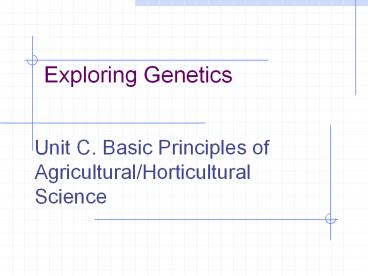Exploring Genetics - PowerPoint PPT Presentation
1 / 21
Title:
Exploring Genetics
Description:
Exploring Genetics Unit C. Basic Principles of Agricultural/Horticultural Science Problem Area 3. Understanding Cells, Genetics, and Reproduction – PowerPoint PPT presentation
Number of Views:102
Avg rating:3.0/5.0
Title: Exploring Genetics
1
Exploring Genetics
- Unit C. Basic Principles of Agricultural/Horticult
ural Science - Problem Area 3. Understanding Cells, Genetics,
and Reproduction
2
Next Generation Science/Common Core Standards
Addressed!
- MS-LS2-4. Construct an argument supported by
empirical evidence that changes to physical or
biological components of an ecosystem affect
populations. Clarification Statement Emphasis
is on recognizing patterns in data and making
warranted inferences about changes in
populations, and on evaluating empirical evidence
supporting arguments about changes to
ecosystems. - RST.6-8.1 Cite specific textual evidence to
support analysis of science and technical texts.
(MS-LS1-6),(MS-LS2-1),(MS-LS2-4) - RST.6-8.2 Determine the central ideas or
conclusions of a text provide an accurate
summary of the text distinct from prior knowledge
or opinions. - 6.RP.A.3 Summarize numerical data sets in
relation to their context. (MS-LS2-2)
3
Bell Work!
- Explain how genotype and phenotype are different.
- Describe how the gender of offspring is
determined. - Distinguish between qualitative and quantitative
inheritance
4
Terms
- Gamete
- Zygote
- Chromosome
- Genotype
- Phenotype
- Allele
- Heterozygous
- Homozygous
- Dominant
- Recessive
- Offspring
- Trait
5
What determines the gender of offspring?
- The study of genetics is concerned with the
transfer of traits. - Gregor Mendel discovered that these traits are
inherited through units called genes. - Genes were found in pairs and half of the
inherited traits come from the father and half
from the mother.
6
Gametes
- Sex cells! Known as the sperm from the male and
egg from the female, - Meet in fertilization and mix genetic material
from both. - The resulting zygote contains genes from both
mother and father, and displays characteristics
from both.
7
Determination of the sex
- Depends on the sex chromosomes.
- Male sex chromosomes are either X or Y.
- The male makes sex determination as all eggs from
female receive an X chromosome. - Female zygote will have two X chromosomes (XX)
while a male zygote will have one X and one Y
chromosome (XY).
8
(No Transcript)
9
The same thing may happen with color!
- Black Bull!
- Black Cow!
10
How are genotype and phenotype different?
- Genotype is the actual genetic code.
- It controls physical and performance traits.
- The genotype of an organism cannot be changed by
environmental factors.
11
Phenotype
- Is the organisms physical or outward appearance.
- This is the part of the genotype the organism
expresses or shows. - In some instances, phenotype may be altered by
the organisms environment.
12
Homozygous
- A homozygous organism is one having similar
alleles or genes on the DNA molecule for a
particular trait.
13
Heterozygous
- A heterozygous organism is one having different
alleles for a particular trait.
14
What is the difference between qualitative and
quantitative traits?
- Qualitative traits are traits controlled only by
a single pair of genes and cannot be altered by
the environment. - These traits most easily show how genes are
inherited. - An example is coat color.
15
Quantitative traits
- Traits controlled by several pairs of genes.
- These traits are expressed across a range.
- These traits can also be altered by environment.
- Examples include rate of gain, growth rate,
backfat depth, etc.
16
Expression of Traits
- Not all traits contained within an organism are
expressed. - Dominant traits cover up or mask the alleles for
recessive traits.
17
Expression of Traits
- In some organisms there are cases of codominance
of traits in which both dominant and recessive
genes are expressed. - Incomplete dominance may also occur.
- This happens when a blending of the allele pair
is expressed.
18
(No Transcript)
19
(No Transcript)
20
(No Transcript)
21
(No Transcript)































